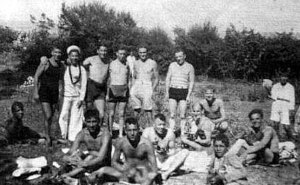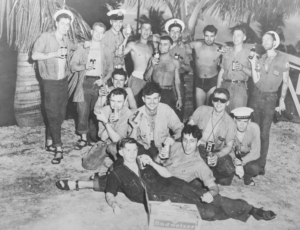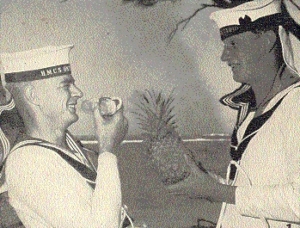BANYAN DAYS were meatless days in the diet of seamen in the English Navy, so called from the name of Hindu merchants noted for their abstinence from eating flesh.
The custom was introduced during the reign of Queen Elizabeth I to economize on the cost of meat, fish or cheese being issued on banyan days in place of salt meat.
Definition from The Oxford Companion to Ships and the Sea
An example of a naval custom that continues to evolve over the years is the banyan. The term originates from the ‘banian’, a garment worn by an East Indian sect who neither kill nor eat meat. The custom of having banyans began in the 18th century as an austerity measure. The British navy, to save money, denied its sailors meat on Mondays, Wednesdays, and Fridays. These days were known as banian (or Banyan) days. In modern times, naval banyans are anything but austere.
A banyan is a special kind of navy party. In spite of the changing nature of the banyan, there are three constants: it is always a fun occasion, it is held outdoors, and the emphasis is on good food, good drink and good friends – something along the lines of an old-fashioned picnic. Nowadays, a banyan is a barbecue or party, usually with steaks and beer.
The idea of parties ashore in rather isolated locations continued, particularly in training squadrons, well into the 1950s. After a week of strenuous training exercises, watch and watch about, day and night, frigates such as HMCS BEACON HILL and HMCS ANTIGONISH would send all but the watch ashore in Bedwell Harbour or near Port Hardy in British Columbia waters for a banyan of beer and burgers. In such places there were no distractions, and sailors under training were unlikely to get into trouble.
In 1971, when Her Majesty the Queen was in British Columbia waters in HM Yacht Britannia, the Royal Family, en route from Powell River to Comox, put ashore in Stag Bay for a quiet picnic. This allowed one of the escorts, the destroyer HMCS QU’APPELLE, a bit of relaxation. After a full day of activities, including a fishing derby, crab hunting and oyster picking, all hands enjoyed a quarterdeck banyan of steaks and broiled oysters.
While sailors always look forward to getting ashore, the banyan, owing to social and technological advances, may be changing. Sailors today tend to be better educated and more sophisticated than their predecessors. As a result, and in spite of the attractions of big city ports, banyan-like parties today are often held right aboard ship, even in harbour.
Even submariners, with their restricted upper deck, have been known to enjoy the occasional banyan. Providing the sea is quiet, to avoid someone being washed overboard from the narrow casing, a half oil drum can barbecue the most tasty steaks to be downed with a cool beer beneath a sunny sky.

HMS Cossack crew enjoying a banyan in Malta 1938/1939. Photo courtesy of The HMS Cossack Association’.
Finally, there is a more recent new twist to the banyan, as evidenced by the experience of the ship’s company of HMCS PRESERVER. Traditionally, the banyan has always been a self-starter, the initiative coming from within the ship.
In 1974, when PRESERVER landed many tons of supplies as a gift from Canada to the people of an isolated parish in Haiti, the Haitians responded by joining PRESERVER’s company in one tremendous banyan on a nearby island. The party featured calypso music and folk dancing as well as the ship’s band, a very colourful scene under gasoline-generated lighting rigged by the ship’s electricians.
By Clare Sharpe
Museum Exhibit Designer/Webmaster


 CFB Esquimalt Naval and Military Museum
CFB Esquimalt Naval and Military Museum CFB Esquimalt Naval and Military Museum
CFB Esquimalt Naval and Military Museum CFB Esquimalt Naval and Military Museum
CFB Esquimalt Naval and Military Museum CFB Esquimalt Naval and Military Museum
CFB Esquimalt Naval and Military Museum CFB Esquimalt Naval and Military Museum
CFB Esquimalt Naval and Military Museum CFB Esquimalt Naval and Military Museum
CFB Esquimalt Naval and Military Museum CFB Esquimalt Naval and Military Museum
CFB Esquimalt Naval and Military Museum CFB Esquimalt Naval and Military Museum
CFB Esquimalt Naval and Military Museum CFB Esquimalt Naval and Military Museum
CFB Esquimalt Naval and Military Museum CFB Esquimalt Naval and Military Museum
CFB Esquimalt Naval and Military Museum CFB Esquimalt Naval and Military Museum
CFB Esquimalt Naval and Military Museum CFB Esquimalt Naval and Military Museum
CFB Esquimalt Naval and Military Museum CFB Esquimalt Naval and Military Museum
CFB Esquimalt Naval and Military Museum CFB Esquimalt Naval and Military Museum
CFB Esquimalt Naval and Military Museum CFB Esquimalt Naval and Military Museum
CFB Esquimalt Naval and Military Museum CFB Esquimalt Naval and Military Museum
CFB Esquimalt Naval and Military Museum CFB Esquimalt Naval and Military Museum
CFB Esquimalt Naval and Military Museum